HRM: Examining Training Needs Analysis - A Detailed Literature Review
VerifiedAdded on 2021/09/23
|7
|2014
|133
Literature Review
AI Summary
This literature review examines Training Needs Analysis (TNA) within Human Resource Management, emphasizing its role in organizational and employee development. It covers the purpose of need analysis, circumstances necessitating TNA, steps involved, its role in organizational change, and ethical considerations. The review synthesizes various perspectives, highlighting TNA's importance in aligning training with organizational objectives and adapting to technological advancements. It also addresses criticisms regarding its traditional, time-consuming nature and potential ethical issues. The analysis underscores the necessity of TNA for effective training programs that address skill gaps, improve performance, and support overall organizational goals, while acknowledging the need for ethical implementation and consideration of alternative performance development strategies. Desklib provides this and other solved assignments for students.
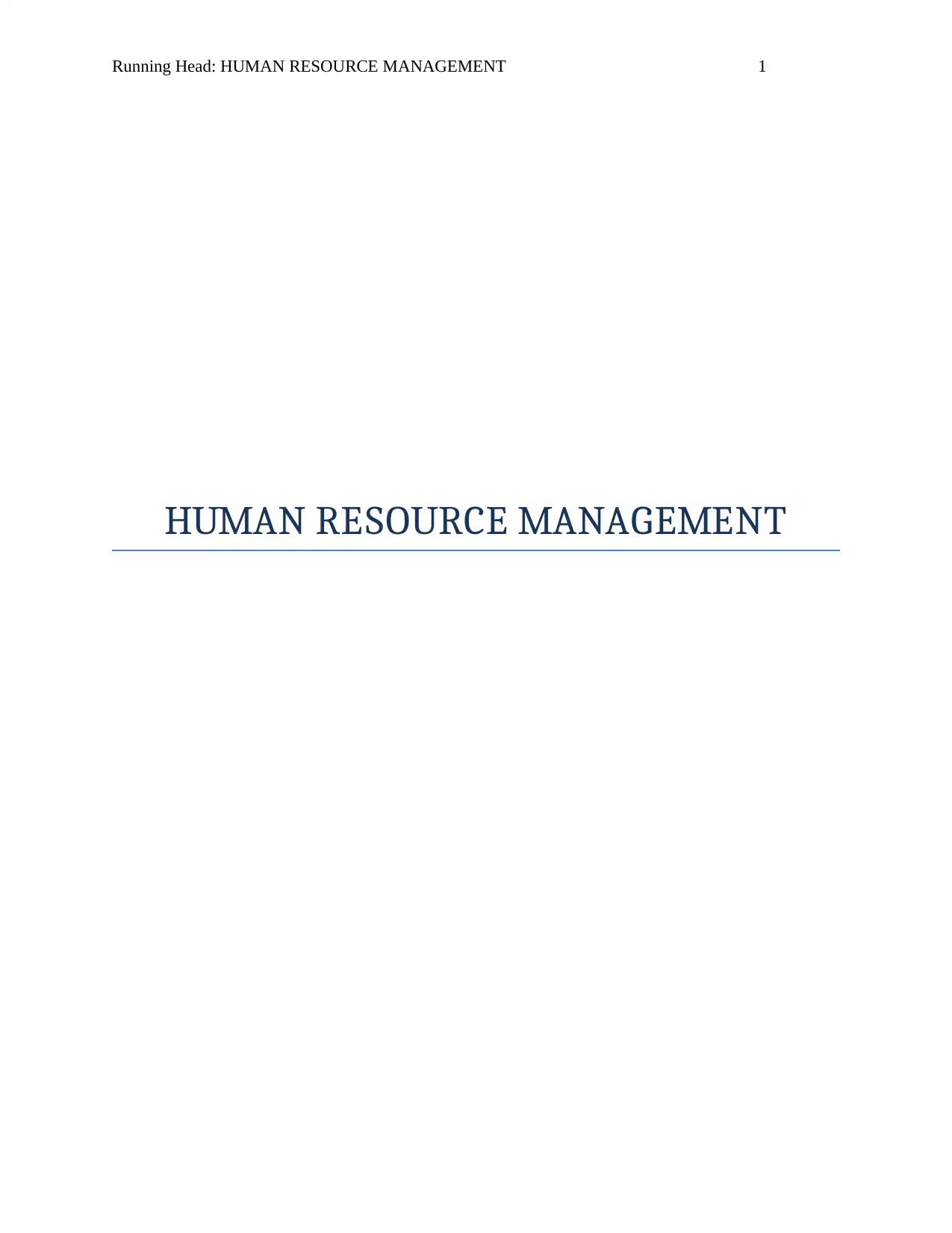
Running Head: HUMAN RESOURCE MANAGEMENT 1
HUMAN RESOURCE MANAGEMENT
HUMAN RESOURCE MANAGEMENT
Paraphrase This Document
Need a fresh take? Get an instant paraphrase of this document with our AI Paraphraser
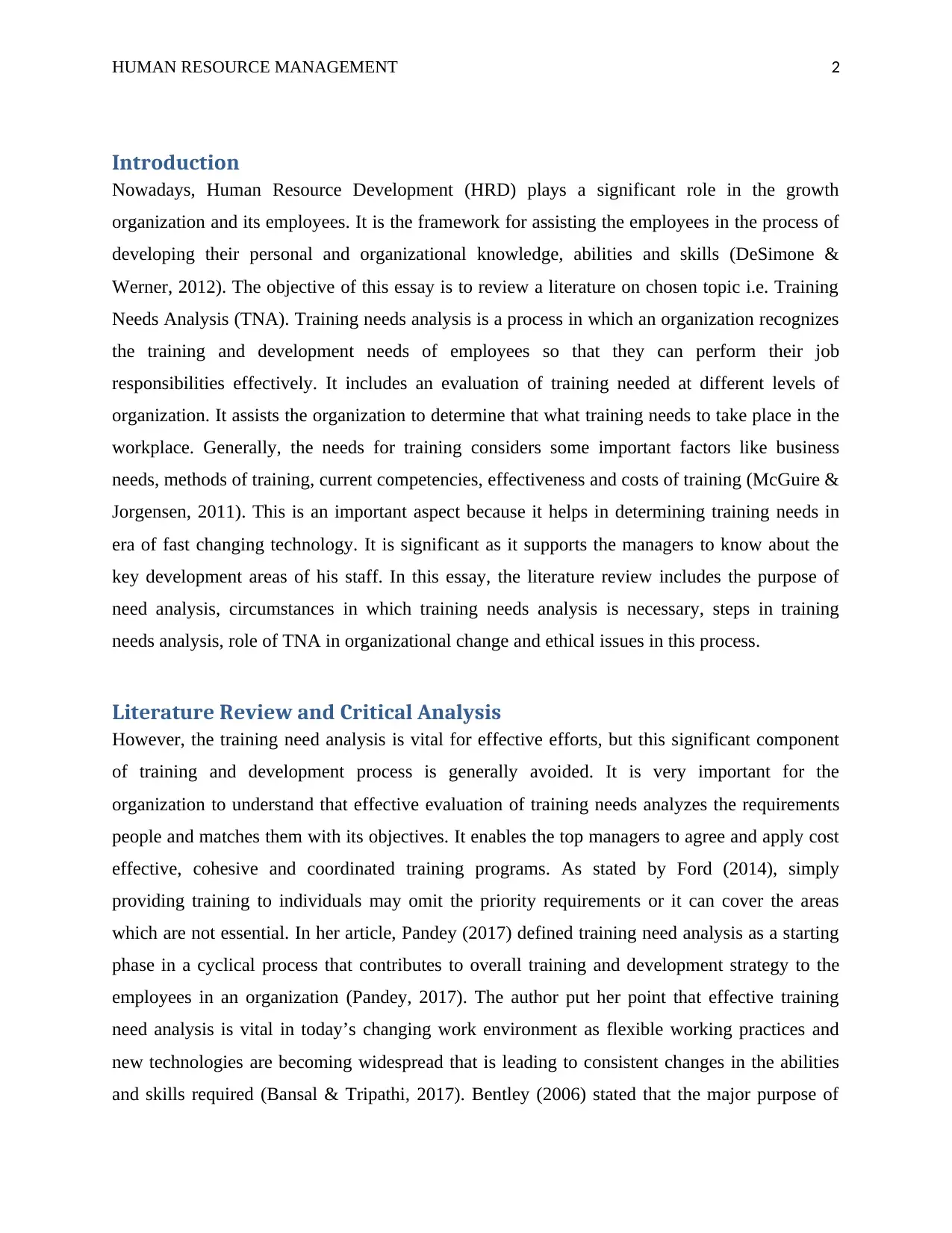
HUMAN RESOURCE MANAGEMENT 2
Introduction
Nowadays, Human Resource Development (HRD) plays a significant role in the growth
organization and its employees. It is the framework for assisting the employees in the process of
developing their personal and organizational knowledge, abilities and skills (DeSimone &
Werner, 2012). The objective of this essay is to review a literature on chosen topic i.e. Training
Needs Analysis (TNA). Training needs analysis is a process in which an organization recognizes
the training and development needs of employees so that they can perform their job
responsibilities effectively. It includes an evaluation of training needed at different levels of
organization. It assists the organization to determine that what training needs to take place in the
workplace. Generally, the needs for training considers some important factors like business
needs, methods of training, current competencies, effectiveness and costs of training (McGuire &
Jorgensen, 2011). This is an important aspect because it helps in determining training needs in
era of fast changing technology. It is significant as it supports the managers to know about the
key development areas of his staff. In this essay, the literature review includes the purpose of
need analysis, circumstances in which training needs analysis is necessary, steps in training
needs analysis, role of TNA in organizational change and ethical issues in this process.
Literature Review and Critical Analysis
However, the training need analysis is vital for effective efforts, but this significant component
of training and development process is generally avoided. It is very important for the
organization to understand that effective evaluation of training needs analyzes the requirements
people and matches them with its objectives. It enables the top managers to agree and apply cost
effective, cohesive and coordinated training programs. As stated by Ford (2014), simply
providing training to individuals may omit the priority requirements or it can cover the areas
which are not essential. In her article, Pandey (2017) defined training need analysis as a starting
phase in a cyclical process that contributes to overall training and development strategy to the
employees in an organization (Pandey, 2017). The author put her point that effective training
need analysis is vital in today’s changing work environment as flexible working practices and
new technologies are becoming widespread that is leading to consistent changes in the abilities
and skills required (Bansal & Tripathi, 2017). Bentley (2006) stated that the major purpose of
Introduction
Nowadays, Human Resource Development (HRD) plays a significant role in the growth
organization and its employees. It is the framework for assisting the employees in the process of
developing their personal and organizational knowledge, abilities and skills (DeSimone &
Werner, 2012). The objective of this essay is to review a literature on chosen topic i.e. Training
Needs Analysis (TNA). Training needs analysis is a process in which an organization recognizes
the training and development needs of employees so that they can perform their job
responsibilities effectively. It includes an evaluation of training needed at different levels of
organization. It assists the organization to determine that what training needs to take place in the
workplace. Generally, the needs for training considers some important factors like business
needs, methods of training, current competencies, effectiveness and costs of training (McGuire &
Jorgensen, 2011). This is an important aspect because it helps in determining training needs in
era of fast changing technology. It is significant as it supports the managers to know about the
key development areas of his staff. In this essay, the literature review includes the purpose of
need analysis, circumstances in which training needs analysis is necessary, steps in training
needs analysis, role of TNA in organizational change and ethical issues in this process.
Literature Review and Critical Analysis
However, the training need analysis is vital for effective efforts, but this significant component
of training and development process is generally avoided. It is very important for the
organization to understand that effective evaluation of training needs analyzes the requirements
people and matches them with its objectives. It enables the top managers to agree and apply cost
effective, cohesive and coordinated training programs. As stated by Ford (2014), simply
providing training to individuals may omit the priority requirements or it can cover the areas
which are not essential. In her article, Pandey (2017) defined training need analysis as a starting
phase in a cyclical process that contributes to overall training and development strategy to the
employees in an organization (Pandey, 2017). The author put her point that effective training
need analysis is vital in today’s changing work environment as flexible working practices and
new technologies are becoming widespread that is leading to consistent changes in the abilities
and skills required (Bansal & Tripathi, 2017). Bentley (2006) stated that the major purpose of
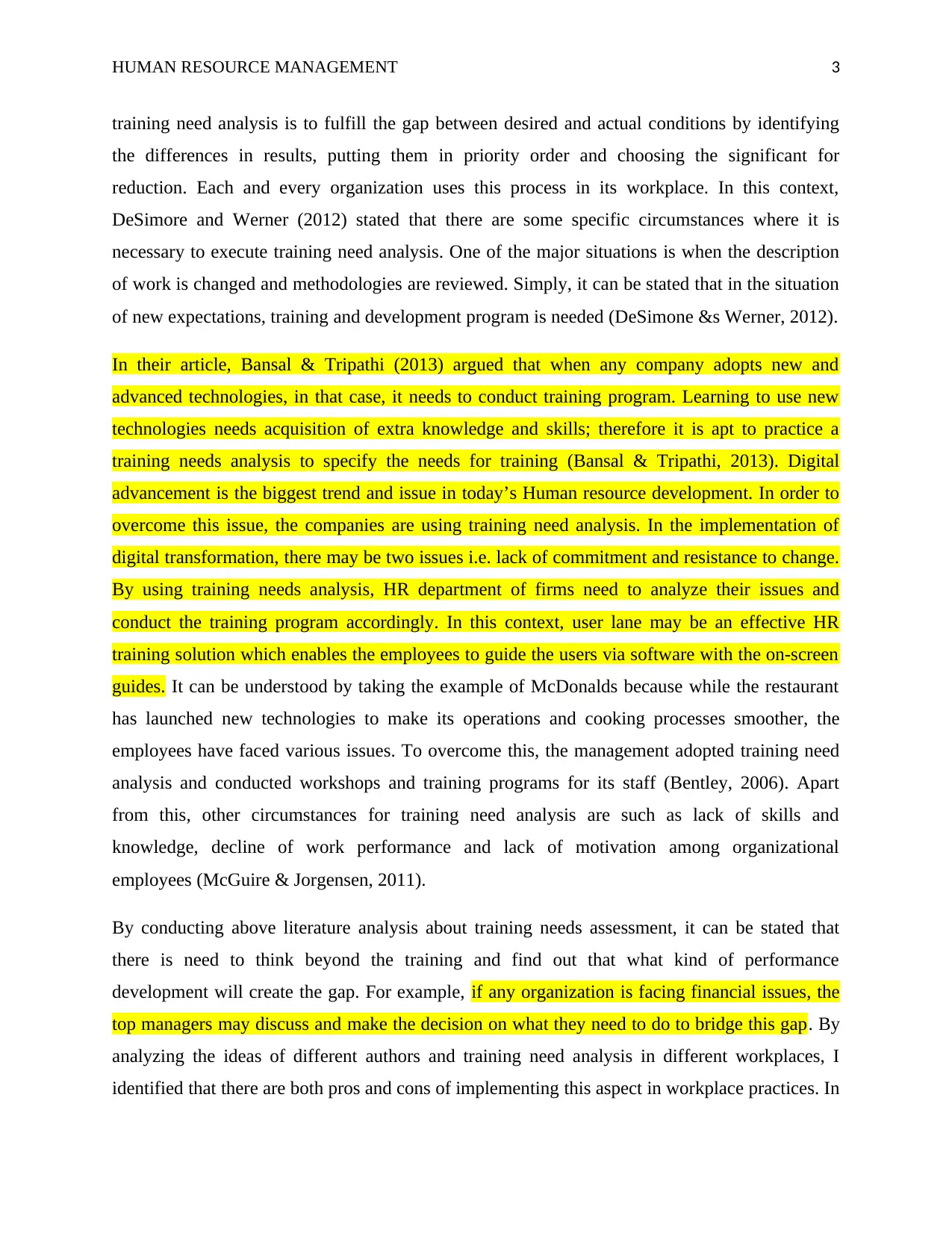
HUMAN RESOURCE MANAGEMENT 3
training need analysis is to fulfill the gap between desired and actual conditions by identifying
the differences in results, putting them in priority order and choosing the significant for
reduction. Each and every organization uses this process in its workplace. In this context,
DeSimore and Werner (2012) stated that there are some specific circumstances where it is
necessary to execute training need analysis. One of the major situations is when the description
of work is changed and methodologies are reviewed. Simply, it can be stated that in the situation
of new expectations, training and development program is needed (DeSimone &s Werner, 2012).
In their article, Bansal & Tripathi (2013) argued that when any company adopts new and
advanced technologies, in that case, it needs to conduct training program. Learning to use new
technologies needs acquisition of extra knowledge and skills; therefore it is apt to practice a
training needs analysis to specify the needs for training (Bansal & Tripathi, 2013). Digital
advancement is the biggest trend and issue in today’s Human resource development. In order to
overcome this issue, the companies are using training need analysis. In the implementation of
digital transformation, there may be two issues i.e. lack of commitment and resistance to change.
By using training needs analysis, HR department of firms need to analyze their issues and
conduct the training program accordingly. In this context, user lane may be an effective HR
training solution which enables the employees to guide the users via software with the on-screen
guides. It can be understood by taking the example of McDonalds because while the restaurant
has launched new technologies to make its operations and cooking processes smoother, the
employees have faced various issues. To overcome this, the management adopted training need
analysis and conducted workshops and training programs for its staff (Bentley, 2006). Apart
from this, other circumstances for training need analysis are such as lack of skills and
knowledge, decline of work performance and lack of motivation among organizational
employees (McGuire & Jorgensen, 2011).
By conducting above literature analysis about training needs assessment, it can be stated that
there is need to think beyond the training and find out that what kind of performance
development will create the gap. For example, if any organization is facing financial issues, the
top managers may discuss and make the decision on what they need to do to bridge this gap. By
analyzing the ideas of different authors and training need analysis in different workplaces, I
identified that there are both pros and cons of implementing this aspect in workplace practices. In
training need analysis is to fulfill the gap between desired and actual conditions by identifying
the differences in results, putting them in priority order and choosing the significant for
reduction. Each and every organization uses this process in its workplace. In this context,
DeSimore and Werner (2012) stated that there are some specific circumstances where it is
necessary to execute training need analysis. One of the major situations is when the description
of work is changed and methodologies are reviewed. Simply, it can be stated that in the situation
of new expectations, training and development program is needed (DeSimone &s Werner, 2012).
In their article, Bansal & Tripathi (2013) argued that when any company adopts new and
advanced technologies, in that case, it needs to conduct training program. Learning to use new
technologies needs acquisition of extra knowledge and skills; therefore it is apt to practice a
training needs analysis to specify the needs for training (Bansal & Tripathi, 2013). Digital
advancement is the biggest trend and issue in today’s Human resource development. In order to
overcome this issue, the companies are using training need analysis. In the implementation of
digital transformation, there may be two issues i.e. lack of commitment and resistance to change.
By using training needs analysis, HR department of firms need to analyze their issues and
conduct the training program accordingly. In this context, user lane may be an effective HR
training solution which enables the employees to guide the users via software with the on-screen
guides. It can be understood by taking the example of McDonalds because while the restaurant
has launched new technologies to make its operations and cooking processes smoother, the
employees have faced various issues. To overcome this, the management adopted training need
analysis and conducted workshops and training programs for its staff (Bentley, 2006). Apart
from this, other circumstances for training need analysis are such as lack of skills and
knowledge, decline of work performance and lack of motivation among organizational
employees (McGuire & Jorgensen, 2011).
By conducting above literature analysis about training needs assessment, it can be stated that
there is need to think beyond the training and find out that what kind of performance
development will create the gap. For example, if any organization is facing financial issues, the
top managers may discuss and make the decision on what they need to do to bridge this gap. By
analyzing the ideas of different authors and training need analysis in different workplaces, I
identified that there are both pros and cons of implementing this aspect in workplace practices. In
⊘ This is a preview!⊘
Do you want full access?
Subscribe today to unlock all pages.

Trusted by 1+ million students worldwide
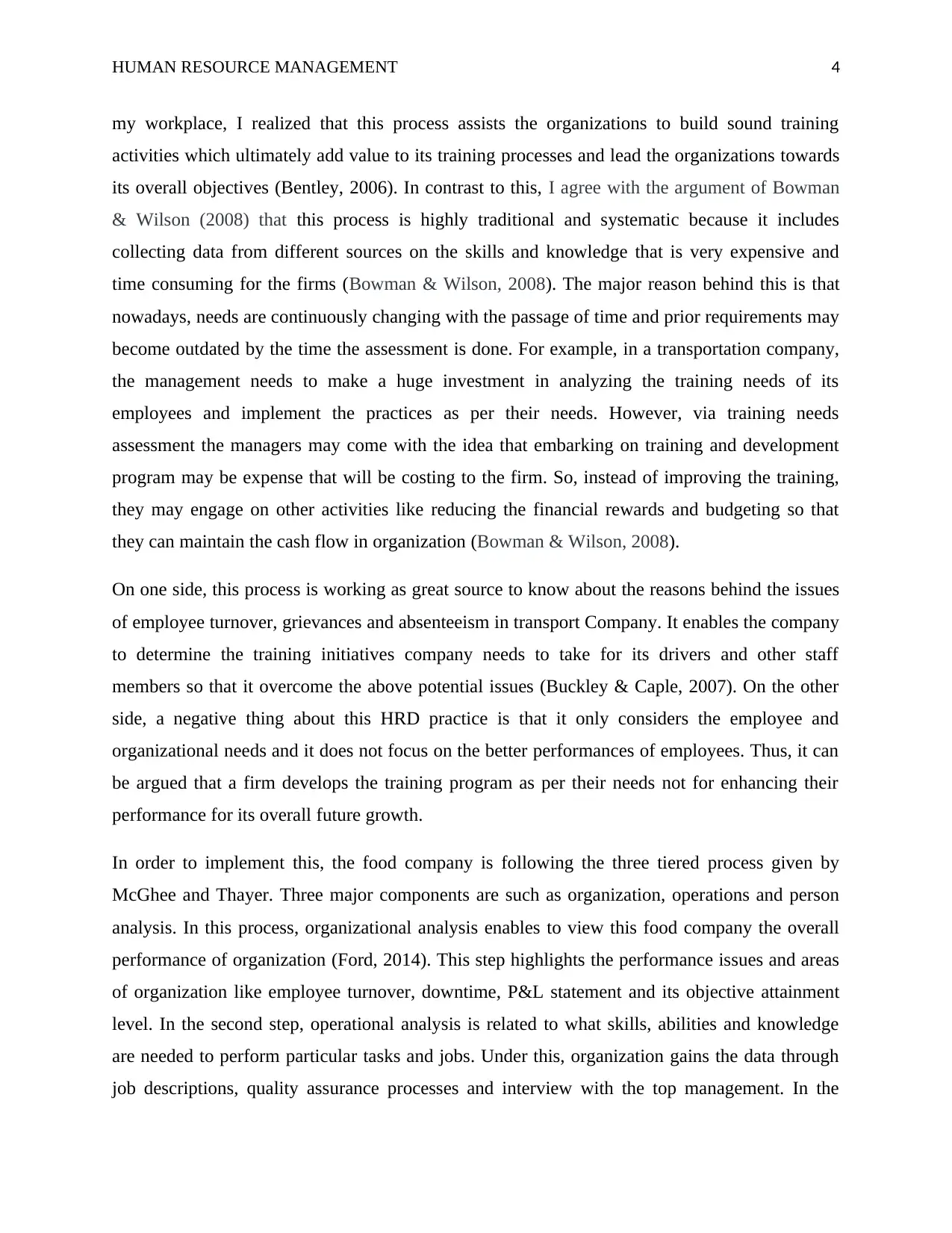
HUMAN RESOURCE MANAGEMENT 4
my workplace, I realized that this process assists the organizations to build sound training
activities which ultimately add value to its training processes and lead the organizations towards
its overall objectives (Bentley, 2006). In contrast to this, I agree with the argument of Bowman
& Wilson (2008) that this process is highly traditional and systematic because it includes
collecting data from different sources on the skills and knowledge that is very expensive and
time consuming for the firms (Bowman & Wilson, 2008). The major reason behind this is that
nowadays, needs are continuously changing with the passage of time and prior requirements may
become outdated by the time the assessment is done. For example, in a transportation company,
the management needs to make a huge investment in analyzing the training needs of its
employees and implement the practices as per their needs. However, via training needs
assessment the managers may come with the idea that embarking on training and development
program may be expense that will be costing to the firm. So, instead of improving the training,
they may engage on other activities like reducing the financial rewards and budgeting so that
they can maintain the cash flow in organization (Bowman & Wilson, 2008).
On one side, this process is working as great source to know about the reasons behind the issues
of employee turnover, grievances and absenteeism in transport Company. It enables the company
to determine the training initiatives company needs to take for its drivers and other staff
members so that it overcome the above potential issues (Buckley & Caple, 2007). On the other
side, a negative thing about this HRD practice is that it only considers the employee and
organizational needs and it does not focus on the better performances of employees. Thus, it can
be argued that a firm develops the training program as per their needs not for enhancing their
performance for its overall future growth.
In order to implement this, the food company is following the three tiered process given by
McGhee and Thayer. Three major components are such as organization, operations and person
analysis. In this process, organizational analysis enables to view this food company the overall
performance of organization (Ford, 2014). This step highlights the performance issues and areas
of organization like employee turnover, downtime, P&L statement and its objective attainment
level. In the second step, operational analysis is related to what skills, abilities and knowledge
are needed to perform particular tasks and jobs. Under this, organization gains the data through
job descriptions, quality assurance processes and interview with the top management. In the
my workplace, I realized that this process assists the organizations to build sound training
activities which ultimately add value to its training processes and lead the organizations towards
its overall objectives (Bentley, 2006). In contrast to this, I agree with the argument of Bowman
& Wilson (2008) that this process is highly traditional and systematic because it includes
collecting data from different sources on the skills and knowledge that is very expensive and
time consuming for the firms (Bowman & Wilson, 2008). The major reason behind this is that
nowadays, needs are continuously changing with the passage of time and prior requirements may
become outdated by the time the assessment is done. For example, in a transportation company,
the management needs to make a huge investment in analyzing the training needs of its
employees and implement the practices as per their needs. However, via training needs
assessment the managers may come with the idea that embarking on training and development
program may be expense that will be costing to the firm. So, instead of improving the training,
they may engage on other activities like reducing the financial rewards and budgeting so that
they can maintain the cash flow in organization (Bowman & Wilson, 2008).
On one side, this process is working as great source to know about the reasons behind the issues
of employee turnover, grievances and absenteeism in transport Company. It enables the company
to determine the training initiatives company needs to take for its drivers and other staff
members so that it overcome the above potential issues (Buckley & Caple, 2007). On the other
side, a negative thing about this HRD practice is that it only considers the employee and
organizational needs and it does not focus on the better performances of employees. Thus, it can
be argued that a firm develops the training program as per their needs not for enhancing their
performance for its overall future growth.
In order to implement this, the food company is following the three tiered process given by
McGhee and Thayer. Three major components are such as organization, operations and person
analysis. In this process, organizational analysis enables to view this food company the overall
performance of organization (Ford, 2014). This step highlights the performance issues and areas
of organization like employee turnover, downtime, P&L statement and its objective attainment
level. In the second step, operational analysis is related to what skills, abilities and knowledge
are needed to perform particular tasks and jobs. Under this, organization gains the data through
job descriptions, quality assurance processes and interview with the top management. In the
Paraphrase This Document
Need a fresh take? Get an instant paraphrase of this document with our AI Paraphraser
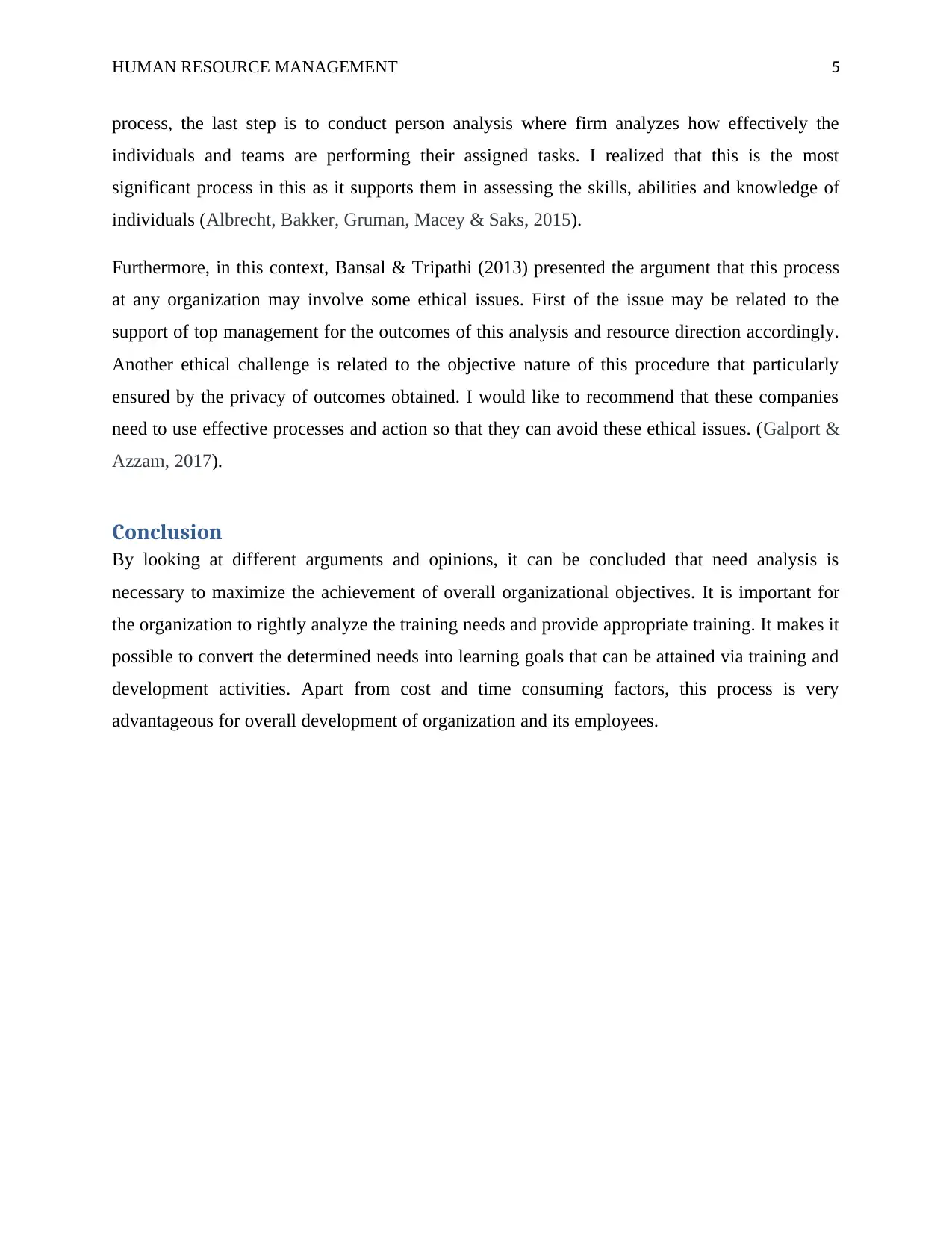
HUMAN RESOURCE MANAGEMENT 5
process, the last step is to conduct person analysis where firm analyzes how effectively the
individuals and teams are performing their assigned tasks. I realized that this is the most
significant process in this as it supports them in assessing the skills, abilities and knowledge of
individuals (Albrecht, Bakker, Gruman, Macey & Saks, 2015).
Furthermore, in this context, Bansal & Tripathi (2013) presented the argument that this process
at any organization may involve some ethical issues. First of the issue may be related to the
support of top management for the outcomes of this analysis and resource direction accordingly.
Another ethical challenge is related to the objective nature of this procedure that particularly
ensured by the privacy of outcomes obtained. I would like to recommend that these companies
need to use effective processes and action so that they can avoid these ethical issues. (Galport &
Azzam, 2017).
Conclusion
By looking at different arguments and opinions, it can be concluded that need analysis is
necessary to maximize the achievement of overall organizational objectives. It is important for
the organization to rightly analyze the training needs and provide appropriate training. It makes it
possible to convert the determined needs into learning goals that can be attained via training and
development activities. Apart from cost and time consuming factors, this process is very
advantageous for overall development of organization and its employees.
process, the last step is to conduct person analysis where firm analyzes how effectively the
individuals and teams are performing their assigned tasks. I realized that this is the most
significant process in this as it supports them in assessing the skills, abilities and knowledge of
individuals (Albrecht, Bakker, Gruman, Macey & Saks, 2015).
Furthermore, in this context, Bansal & Tripathi (2013) presented the argument that this process
at any organization may involve some ethical issues. First of the issue may be related to the
support of top management for the outcomes of this analysis and resource direction accordingly.
Another ethical challenge is related to the objective nature of this procedure that particularly
ensured by the privacy of outcomes obtained. I would like to recommend that these companies
need to use effective processes and action so that they can avoid these ethical issues. (Galport &
Azzam, 2017).
Conclusion
By looking at different arguments and opinions, it can be concluded that need analysis is
necessary to maximize the achievement of overall organizational objectives. It is important for
the organization to rightly analyze the training needs and provide appropriate training. It makes it
possible to convert the determined needs into learning goals that can be attained via training and
development activities. Apart from cost and time consuming factors, this process is very
advantageous for overall development of organization and its employees.
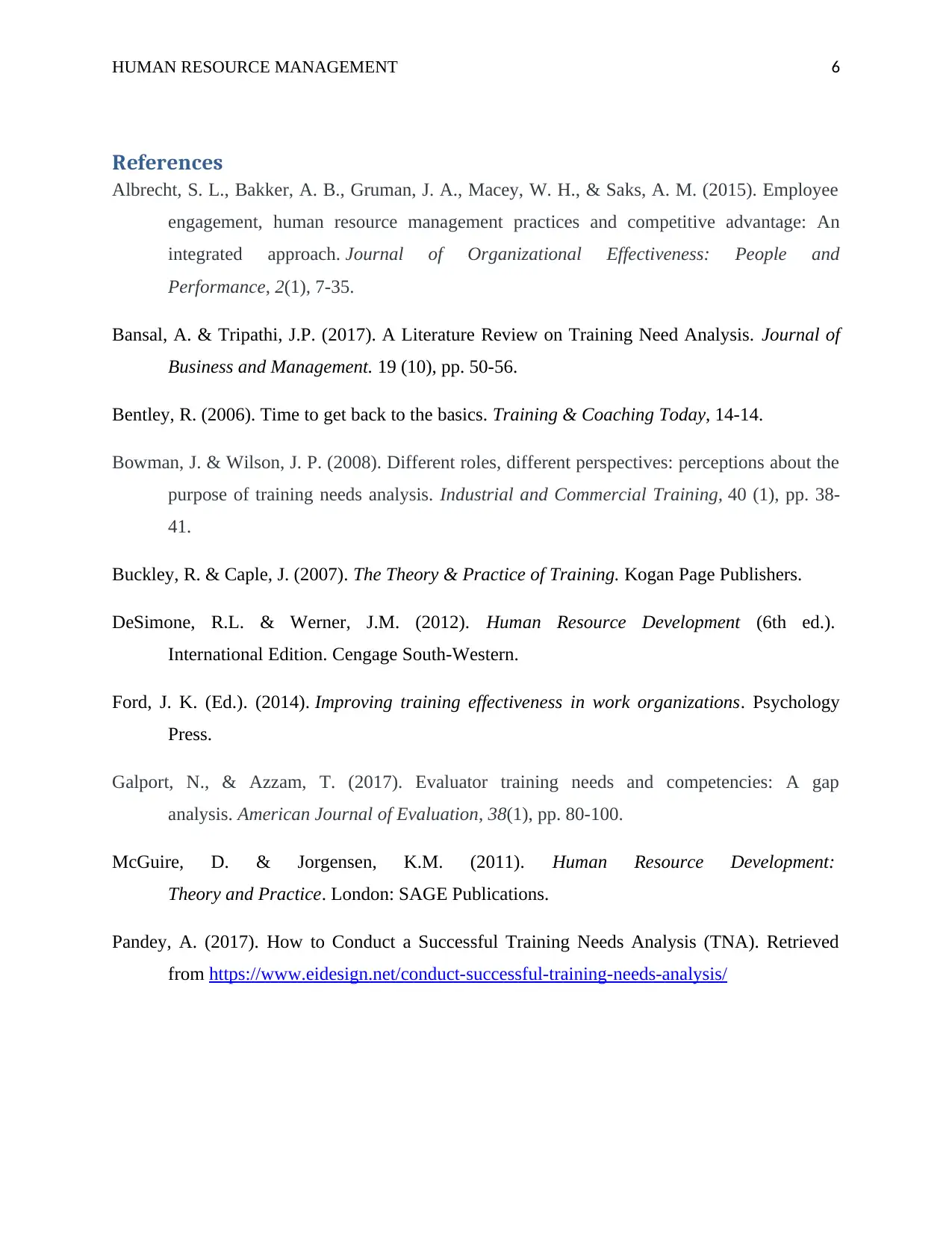
HUMAN RESOURCE MANAGEMENT 6
References
Albrecht, S. L., Bakker, A. B., Gruman, J. A., Macey, W. H., & Saks, A. M. (2015). Employee
engagement, human resource management practices and competitive advantage: An
integrated approach. Journal of Organizational Effectiveness: People and
Performance, 2(1), 7-35.
Bansal, A. & Tripathi, J.P. (2017). A Literature Review on Training Need Analysis. Journal of
Business and Management. 19 (10), pp. 50-56.
Bentley, R. (2006). Time to get back to the basics. Training & Coaching Today, 14-14.
Bowman, J. & Wilson, J. P. (2008). Different roles, different perspectives: perceptions about the
purpose of training needs analysis. Industrial and Commercial Training, 40 (1), pp. 38-
41.
Buckley, R. & Caple, J. (2007). The Theory & Practice of Training. Kogan Page Publishers.
DeSimone, R.L. & Werner, J.M. (2012). Human Resource Development (6th ed.).
International Edition. Cengage South-Western.
Ford, J. K. (Ed.). (2014). Improving training effectiveness in work organizations. Psychology
Press.
Galport, N., & Azzam, T. (2017). Evaluator training needs and competencies: A gap
analysis. American Journal of Evaluation, 38(1), pp. 80-100.
McGuire, D. & Jorgensen, K.M. (2011). Human Resource Development:
Theory and Practice. London: SAGE Publications.
Pandey, A. (2017). How to Conduct a Successful Training Needs Analysis (TNA). Retrieved
from https://www.eidesign.net/conduct-successful-training-needs-analysis/
References
Albrecht, S. L., Bakker, A. B., Gruman, J. A., Macey, W. H., & Saks, A. M. (2015). Employee
engagement, human resource management practices and competitive advantage: An
integrated approach. Journal of Organizational Effectiveness: People and
Performance, 2(1), 7-35.
Bansal, A. & Tripathi, J.P. (2017). A Literature Review on Training Need Analysis. Journal of
Business and Management. 19 (10), pp. 50-56.
Bentley, R. (2006). Time to get back to the basics. Training & Coaching Today, 14-14.
Bowman, J. & Wilson, J. P. (2008). Different roles, different perspectives: perceptions about the
purpose of training needs analysis. Industrial and Commercial Training, 40 (1), pp. 38-
41.
Buckley, R. & Caple, J. (2007). The Theory & Practice of Training. Kogan Page Publishers.
DeSimone, R.L. & Werner, J.M. (2012). Human Resource Development (6th ed.).
International Edition. Cengage South-Western.
Ford, J. K. (Ed.). (2014). Improving training effectiveness in work organizations. Psychology
Press.
Galport, N., & Azzam, T. (2017). Evaluator training needs and competencies: A gap
analysis. American Journal of Evaluation, 38(1), pp. 80-100.
McGuire, D. & Jorgensen, K.M. (2011). Human Resource Development:
Theory and Practice. London: SAGE Publications.
Pandey, A. (2017). How to Conduct a Successful Training Needs Analysis (TNA). Retrieved
from https://www.eidesign.net/conduct-successful-training-needs-analysis/
⊘ This is a preview!⊘
Do you want full access?
Subscribe today to unlock all pages.

Trusted by 1+ million students worldwide
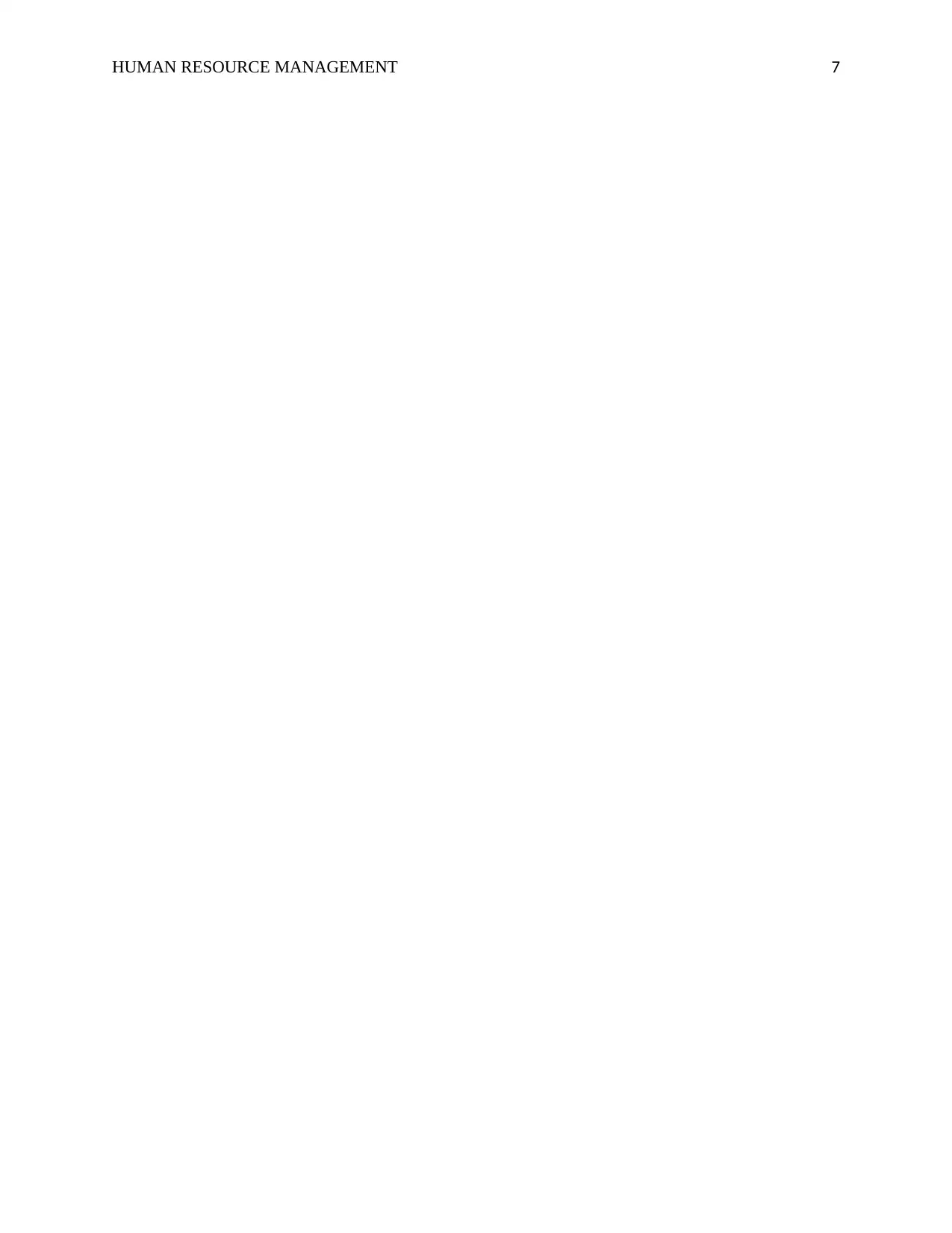
HUMAN RESOURCE MANAGEMENT 7
1 out of 7
Related Documents
Your All-in-One AI-Powered Toolkit for Academic Success.
+13062052269
info@desklib.com
Available 24*7 on WhatsApp / Email
![[object Object]](/_next/static/media/star-bottom.7253800d.svg)
Unlock your academic potential
Copyright © 2020–2025 A2Z Services. All Rights Reserved. Developed and managed by ZUCOL.




